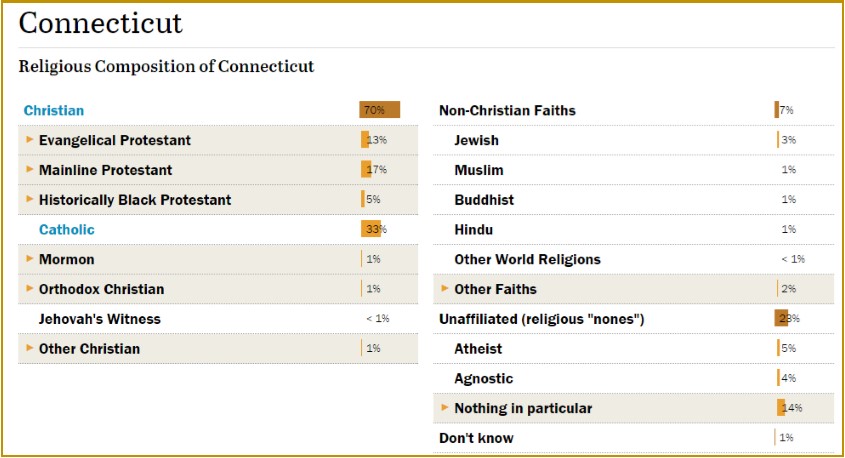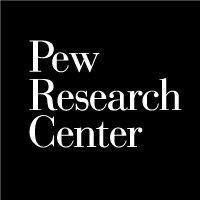Percentage of Christians in America, Catholics in Connecticut Drops, New Study Finds
/The Christian share of the U.S. population is declining, while the number of U.S. adults who do not identify with any organized religion is growing nationwide, according to an extensive new survey by the Pew Research Center. The drop in the percentage of Catholic residents in Connecticut was the largest among the states, according to the Pew research data, while the percentage of unaffiliated remained steady. In Connecticut, 33 percent of residents are Catholic, 17 percent are Mainline Protestant, 13 percent are Evangelical Protestant, 5 percent area historically Black Protestant, and 3 percent are Jewish. About one percent of the population in Connecticut are Buddhist, approximately the same percentage as Hindu, Muslim and Mormon, according to the Pew survey, based on 2014 data. The survey indicated that 23 percent are unaffiliated with a religion.
 While the drop in Christian affiliation is particularly pronounced among young adults nationwide, it is occurring among Americans of all ages. The same trends are seen among whites, blacks and Latinos; among both college graduates and adults with only a high school education; and among women as well as men, according to the Pew data.
While the drop in Christian affiliation is particularly pronounced among young adults nationwide, it is occurring among Americans of all ages. The same trends are seen among whites, blacks and Latinos; among both college graduates and adults with only a high school education; and among women as well as men, according to the Pew data.
The major new survey of more than 35,000 Americans by the Pew Research Center finds that the percentage of adults (ages 18 and older) who describe themselves as Christians has dropped by nearly eight percentage points in just seven years, from 78.4 percent in a similarly sized national Pew Research survey in 2007 to 70.6 percent in 2014.
Over the same period, the percentage of Americans who are religiously unaffiliated – describing themselves as atheist, agnostic or “nothing in particular” – has jumped more than six points, from 16.1 percent to 22.8 percent. And the share of Americans who identify with non-Christian faiths also has inched up, rising 1.2 percentage points, from 4.7 percent in 2007 to 5.9 percent in 2014.
In Connecticut, the percentage of Catholics dropped from 43 percent in 2007 to 33 percent in 2014. The 10 percentage point drop among Catholics in Connecticut was the largest in the nation. Massachusetts saw a nine point drop between 2007 and 2014, from 43 percent to 34 percent of that state’s population.
The percentage of Mainline Protestants (13% to 17%), Evangelical Protestants (9% to 13%), historically Black Protestant (4% to 5%), and Jewish residents (1% to 3%), all increased in Connecticut between 2007 and 2014. For the first time, the percentage of Muslim, Buddhist and Hindu residents each reached one percent in the 2014 survey. The percentage of unaffiliated was relatively constant in Connecticut, increasing from 22 percent in 2007 to 23 percent in 2014, as the national percentage grew from 16 percent to 23 percent, matching the Connecticut percentage.
Even as their numbers decline, American Christians – like the U.S. population as a whole – are becoming more racially and ethnically diverse. Religious intermarriage also appears to be on the rise: Among Americans who have gotten married since 2010, nearly four-in-ten (39%) report that they are in religiously mixed marriages, compared with 19% among those who got married before 1960, the Pew analysis pointed out.
Because the U.S. census does not ask Americans about their religion, there are no official government statistics on the religious composition of the U.S. public, Pew noted. The most recent Religious Landscape Study was designed to obtain a minimum of 300 interviews with respondents in each state and the District of Columbia.






























